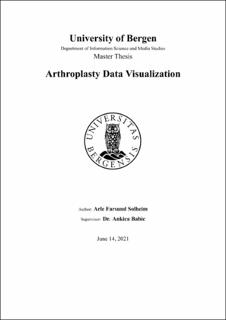Arthroplasty Data Visualization
Master thesis
Permanent lenke
https://hdl.handle.net/11250/2764324Utgivelsesdato
2021-06-15Metadata
Vis full innførselSamlinger
- Master theses [247]
Sammendrag
This master's thesis presents the work done in the field of visualization and interactivity conducted within the Design Science framework. The main goal was to make the data analysis using the arthroplasty register data into a more independent, easy, and user-friendly experience. The visualization artifact was created to support presentation of data material and results from data mining with a purpose of understand patient outcomes, longevity of implants, and present demographic and other data in a more contemporary way. There is a wealth of information and reports at the website of the Norwegian Arthroplasty Register, but very little in terms of interactivity and independent user exploration of data. The work was carried out as a part of a back- and front-end development with data mining methods developed for knee and hip prosthesis data being the back-end, and the front-end consisted of a user interface in addition to visualization. This setup had several advantages, where the selection of data mining methods and implementation of a high-fidelity user interface all contributed to a better user experience of the visualizations. The resulting artifact is comprised of visualizations of demographic data, Kaplan-Meier, and an interactive map of Norway. Interactivity enabled exploring data for selected periods of time, comparison of performance in different prostheses, and exploring patient population behind certain points on a survival graph. The map of Norway offers features such as demographic data and comparison of top 5 prostheses in different counties. The evaluation was carried out with the use of three different evaluation tools and interviews with domain and usability experts. Feedback during interviews was encouraging and indicated the potential usefulness of the visualizations. The system in its current form is more directed towards expert users, but can be easily adjusted to patients and the wider public, which could be a subject of future research. More visualizations and data analytical methods could further enhance the current solutions.
